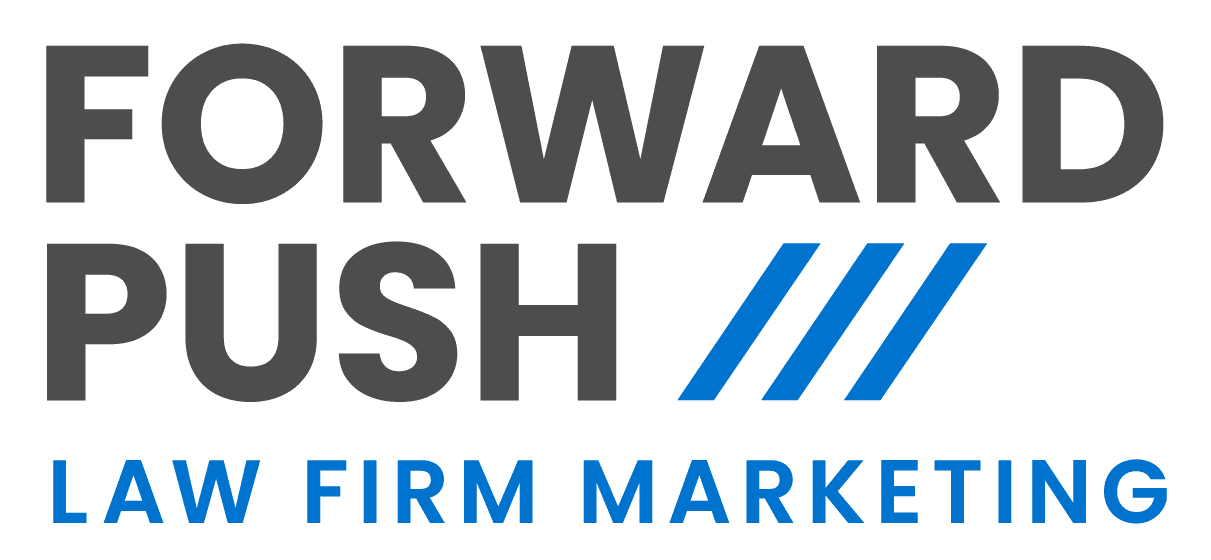By Marc Apple ● ● 7 min read

Table of Contents
TL;DR Whether the business objectives (and corresponding budget) for a law firm website call for a redesign or refresh, both present an opportunity to assess what is and isn't working.
No time to read? Listen to a conversation about this blog post instead.
Understanding the Difference Between a Website Redesign and Refresh
A law firm website redesign involves completely overhauling your firm’s online identity. It is much more extensive than a refresh.
The redesign process is comprehensive and considers the website’s current performance, functionality issues, visitor engagement metrics, visual identity, visual elements, structure, content strategy, and refining content.

With a full law firm website redesign, you essentially create a brand new website from the ground up.
With a full law firm website redesign, you essentially create a brand new website from the ground up.
Eight key aspects of a law firm website redesign include:
- Creating a new visual design, color scheme, typography, and branding
- Reorganizing and restructuring the information architecture
- Conducting a content audit, rewriting content as necessary, optimizing pages for SEO, and adding new content
- Conducting an accessibility audit to ensure the redesign adheres to accessibility standards
- Evaluating navigation and site menus
- Assessing page templates and layouts and optimizing for screen size
- Reviewing website features and tools
- Rebuilding on a new content management system (CMS) platform, if needed
In contrast, law firm websites undergoing a refresh will find that it’s still a comprehensive improvement project, yet it is focused on specific elements of the website.
A law firm website refresh may involve these five things:
- Updating visual elements
- Tweaking a color palette and design elements
- Conducting a content audit, making any updates to the content strategy, adding new pieces of content
- Small tweaks to page layouts to account for screen size, mobile experiences, and accessibility standards
- Adjustments to improve slow page-load times and optimal performance
An effective law firm website refresh breathes new life into your well-designed website without the extensive time and budget required for a full redesign. It modernizes the look and feel of your site and enhances outdated elements.
The Five Elements of a Law Firm Website Audit
1. Assessing Your Firm’s Current Website
Your website’s user experience, usability, and search engine optimization performance is critical before deciding on a refresh or redesign.
2. Analyzing User Experience
Conduct user testing to see how real people interact with your site. Look for pain points, such as difficulty finding information, excessive clicks to complete actions, confusing navigation, or lack of mobile optimization.

Analyze your site analytics to see bounce rates, time on site, and which pages get the most traffic.
Analyze your site analytics to see bounce rates, time on site, and which pages get the most traffic.
3. Identifying Usability Issues Affecting Conversions
Pinpoint usability problems that may prevent visitors from converting into leads and clients. These could include poor call-to-action placement, confusing contact forms, lack of trust indicators, or difficult navigation.
4. Reviewing Search Engine Rankings
Analyze your rankings for keywords and phrases related to your practice. Compare your rankings to competitors. If you have lost ground, it may be time for changes to improve optimization.
5. Evaluating Current SEO Performance
It’s important to take a close look at your SEO performance and identify any areas for improvement. This involves determining your current SEO health by looking at:
- Keyword rankings – Analyze your top target keywords and see where you currently rank
- Technical SEO – Does your site follow best practices for technical SEO? Ask your agency for help in this department.
- Content optimization – Is your content optimized for search?
- Local SEO – If location is important, analyze your local SEO signals
Based on this audit, you can identify gaps where your law firm website needs improvement.
Setting Goals for the Website
When deciding on a website redesign or refresh, it’s important to establish clear goals that align with your overall marketing strategy and objectives.
Set specific, measurable goals like increasing contact form submissions by 25%, boosting monthly traffic by 30%, or improving your website’s page one Google ranking for relevant keywords.
Regardless of whether you pursue a refresh or engage in a redesign, you can really gain momentum and avoid veering off the path if you spend the time here on the front end.
Why You Should Consider User Experience
A key consideration when deciding on a website redesign or refresh is evaluating and enhancing the overall user experience.
Below are nine important factors you need to be looking at before you begin this type of project for your law firm:
1. FAQ Section
Adding a frequently asked questions (FAQ) section can significantly improve user experience. An FAQ page allows you to anticipate common questions from potential clients and provide direct answers. This saves visitors time hunting for information and improves satisfaction.
2. Clear Navigation
Ensure main site sections and pages are easy to locate. Use clear, descriptive main menu options that reflect user intent. Remove redundant or unnecessary pages to declutter navigation.
Test site navigation across desktop, tablet, and mobile devices to identify any issues.
3. Mobile Responsive Design
Ensure your site resizes and reflows correctly across all devices. Content should be rearranged for optimal mobile viewing without horizontal scrolling or zooming.

“Prioritizing user experience builds trust, satisfaction, and conversions,” says Forward Push’s graphic designer Clara Gray.
Evaluate your site analytics and user feedback to identify areas for improvement. Gray adds, “Aim for intuitive navigation, seamless responsiveness, and a streamlined user journey.”
4. Improving Site Speed
Page load time is a critical factor for user experience and SEO. With faster page speeds, users will have a better experience on your site. Your pages will also rank better in search results, leading to more qualified traffic.
5. Enhancing Design
A website redesign presents an opportunity to give your law firm’s site a fresh, modern look that aligns with your brand identity. The visual design should be clean, uncluttered, and easy to navigate.
6. Intuitive Information Architecture
Organize content in a logical way that matches visitor’s expectations. Group related practice areas and services together under main menus and subcategories.
7. Prominent Calls-to-Action (CTA)
Strategically highlight CTAs to guide visitors to complete the desired action. Place CTAs in places like a sidebar to prompt an action like signing up for your newsletter.
8. Optimizing Content
Optimizing your law firm’s website content should be a key focus in any redesign or refresh project.
Make sure pages provide a comprehensive overview of things like your experience, representative cases, location, and how you can help clients.
9. Measuring Results
Careful planning and execution can ensure your new website launch goes smoothly without negatively impacting your SEO. Monitor results closely and be ready to address any issues quickly.
How to Measure and Monitor Website Results
Track Key Metrics
- Monitor traffic sources – Evaluate how people find your site organically.
- Analyze conversion rates – Track how many site visitors become leads by requesting a consultation or signing up for your newsletter.
- Check page views and time on site – More page views and longer durations signal increased engagement.
- Follow rankings in search engines – Higher rankings, especially for key terms, can increase visibility and clicks from search.
Evaluate Against Goals
- Compare metrics to targets – Review your goals for the website refresh and see if your targets were reached in terms of traffic, leads, and revenue.
- Seek client feedback – Ask for clients’ opinions on the new site and seek their suggestions for improvement.
Monitor User Behavior
- Watch click-through rates – See which calls-to-action and links get the most clicks.
- Observe where visitors exit – If many users leave at a certain page, there may be an issue that needs addressing.
- Check mobile vs. desktop – Ensure your website works well on mobile because mobile experiences impact conversions.
Continued optimization is key to achieving your law firm’s business goal when it comes to online marketing.
FAQ Deciding on a Website Redesign or Refresh for Your Law Firm
Why should I consider redesigning or refreshing my law firm website?
A website redesign or refresh can help improve the user experience, update the design to be more modern and responsive, and align with any changes in your branding or services. It can also drive more traffic to the website.
How do I know if my law firm website needs a redesign or refresh?
Consider aspects such as outdated design, slow loading times, not being mobile-friendly, low search engine rankings, or if it does not reflect your current services and brand image.
What are the key components of a successful law firm website redesign or refresh?
Some key components include clear and concise content, intuitive navigation, responsive design for mobile users, updated SEO strategies, engaging visuals, and strong calls to action.
What are the potential challenges in redesigning or refreshing my law firm website?
Challenges may include the potential for downtime, loss of search engine rankings, migration of content and data, and ensuring the new design aligns with your branding and goals.
Should I tackle the website redesign or website refresh myself, or should I hire an agency?
This depends on your level of expertise, time, budget, and available resources. While it’s possible to DIY, hiring a professional agency can ensure a more polished and effective result, while saving you time, money, and effort.
How can I measure the success of my website redesign or website refresh?
Increased website traffic, lower bounce rates, improved search engine rankings, and higher conversion rates can indicate the success of your redesign or refresh.
What is the typical timeline and cost for a law firm website redesign or refresh?
The timeline and cost can vary widely depending on the scope of the project, the complexity of the design and functionality, and whether you hire an agency. It’s important to plan and budget for these factors carefully. Speaking with an agency about a website redesign or refresh never hurts.
How often should I consider redesigning or refreshing my law firm website?
Reviewing and potentially refreshing your website every 2-3 years is generally advisable. This helps to ensure it remains current, relevant, and meets the evolving needs of your clients and your practice.
Are there any legal considerations I should know when redesigning my law firm website?
Yes! Ensure your website complies with legal and ethical regulations related to client confidentiality, advertising standards, website accessibility, and data protection.
What key trends in law firm website design should I consider for my redesign or refresh?
Current trends include a focus on user experience, personalized content, accessibility, interactive elements, and integration with social media and client portals.




